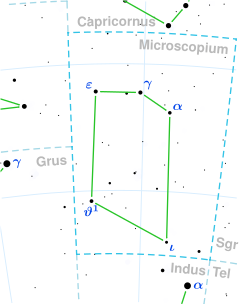Top Qs
Timeline
Chat
Perspective
HD 200073
K-type giant in Microscopium From Wikipedia, the free encyclopedia
Remove ads
HD 200073 (HR 8046; 43 G. Microscopii) is a solitary star located in the southern constellation Microscopium 8.5′ northwest of Zeta Microscopii. It is faintly visible to the naked eye as an orange-hued point of light with an apparent magnitude of 5.94.[2] The object is located relatively close at a distance of 227 light-years based on Gaia DR3 parallax measurements, but it is receding with a heliocentric radial velocity of 39 km/s.[6] At its current distance, HD 200073's brightness is diminished by an interstellar extinction of 0.13 magnitudes[15] and it has an absolute magnitude of +1.79.[7] It has a relatively high proper motion across the celestial sphere, moving at a rate of 213 mas/yr.[1]
HD 200073 has a stellar classification of K2 III,[4] indicating that it is an evolved K-type giant that has exhausted hydrogen at its core and left the main sequence. Astronomer David Stanley Evans gave a class of K0 IV,[5] indicating that it is a slightly evolved subgiant that is ceasing hydrogen fusion at its core. HD 200073 is currently on the red giant branch,[3] fusing hydrogen in a shell around an inert helium core. It has a comparable mass to the Sun[8] but at the age of 8.79 billion years,[12] it has expanded to 9.15 times the radius of the Sun.[9] It radiates 28.8 times the luminosity of the Sun[1] from its enlarged photosphere at an effective temperature of 4,569 K.[10] HD 200073 is slightly metal-deficient with an iron abundance of [Fe/H] = −0.13 or 74.1% of the Sun's.[8] It spins modestly with a projected rotational velocity of 2.7 km/s.[11]
Remove ads
References
Wikiwand - on
Seamless Wikipedia browsing. On steroids.
Remove ads

